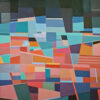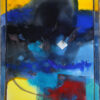In the beginning, as it goes without saying, the realistic expressionism in UAE and Arab World arts are closely related to the academic education of a group of artists who were lucky to receive artistic knowledge by studying abroad in Arab countries, especially Egypt, and in the world, especially USA and Britain. The State made sure to send students to study all kinds of art. Additionally, the vivid interaction with schools and art environment in Kuwait played a vital role in shaping the vision and plans of visual and expressive arts founders in UAE, one of them is Abdul Qader Al Rais. It is also worth mentioning that the positive impact of receiving education in Kuwait has also affected theatre, TV drama, and literature writing.
Talking about expressive visual arts necessarily directs us towards the importance of noticing the chronological, descriptive, and classifying sequence of fine arts… this sequence doesn’t cancel out the need for multiple points of view in the individual type… so the dominant feature in one type or the other could be the starting point through which we can observe the interaction between types of visual arts… expressive art could relate to academic realism in some aspect, it is also adjoining to romanticism and impressionism depending on the artist’s sentiments and emotional measures… it is also fair to say that there are no boundaries between types of fine arts, even if each typed seemed self-independent… This also points toward the importance, classification, and comprehension of the expressionism content that the artists want, and the relevance of that content to the time period and its own existential questions.
From here we can realize the deep connection between different types of art and the artist’s own views emanating from his presence in his community. However, the general objective perspective also relates to the artistic option and expressional style. This means we are obligated first to determine the outlines of realistic expressionism through the following:
First: Scholastic perspective, it exclusively relates to the laws of perspective, configuration, contrast, swarming, vacuum, optics, and balance… and those all are physics laws that apply to all visual arts and fine arts.
Second: the relevance of expressionism and realism arts to the Emirati environment; its seas, mountains, architecture, valleys, and desert… these patterns reflect on the experiences of artists; Abdul Qader Al Rais (Local architecture arts in compliance with ornaments, characters, impressive colorful assumptions, and expressive Barjeels, windows, and concrete). It is also present in Najat Makki works by using aquatic colors, expressive identification of Sadu and fashion arts, Arabesque and Miniatures. Artist Obaid Suroor, also approached the realistic expressionism through his extravagant panoramic works that deploy the features of mountains, valleys, and desert environments.
Third: The realistic expressionism experience had crossed paths with the modern art school, starting from the Impressionism movement, through the Abstraction and Symbolism, up until conceptual arts. In this connection, we can mention the earlier experiences of Artist Hoor Al-Qasimi of merging expressing colorful values and abstract horizons with space for symbolism. We should also mention the late conceptual artist, Hassan Sharif, and his embracing of the local environment connected to conceptual formation arts. The same applies to Artist Abdul Raheem Salem who embraced realistic expressionism through the embodiment patched with abstraction.
While keeping all the previous mentions in mind, there is still a need for a more profound search for signs of realistic expressionism in Emirati fine arts, which we will cover later.
Dr. Omar Abdulaziz holds a doctoral degree in Philosophy and Economic Sciences. He has authored more than 40 publications in the fields of intellect, criticism, novels, and aesthetics. Additionally, Dr. Omar is a visual artist, having held personal exhibitions and participated in events both in the Arabian and international contexts. Beyond his contributions to media and culture management and planning, he has held various leadership roles in these domains and actively participated in academic programs at several universities.
Currently, Dr. Abdulaziz serves as the Head of the Department of Research and Studies at the Department of Culture and Information in Sharjah. Moreover, he holds the position of Chairman of the Board of Directors at the Arab Cultural Club.








